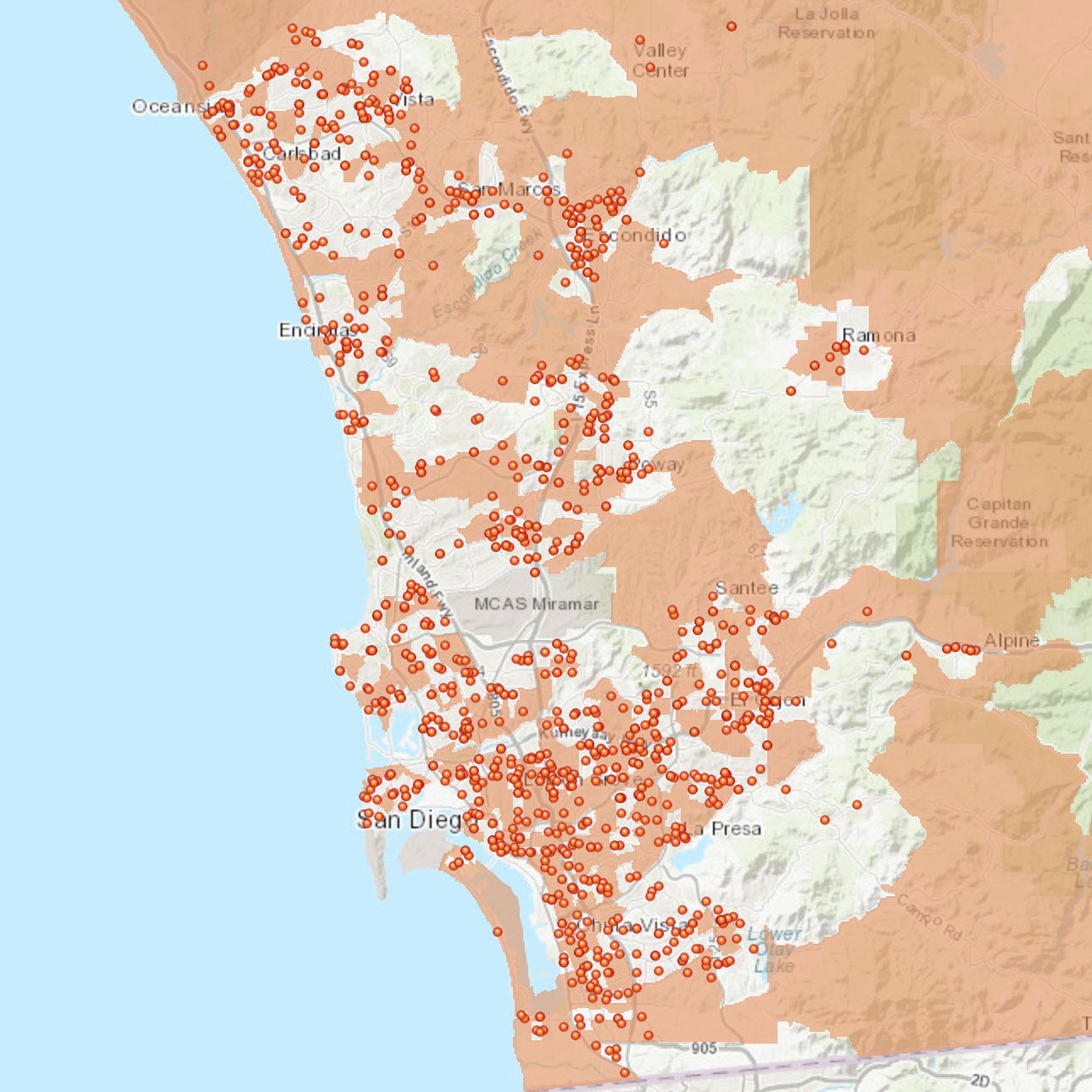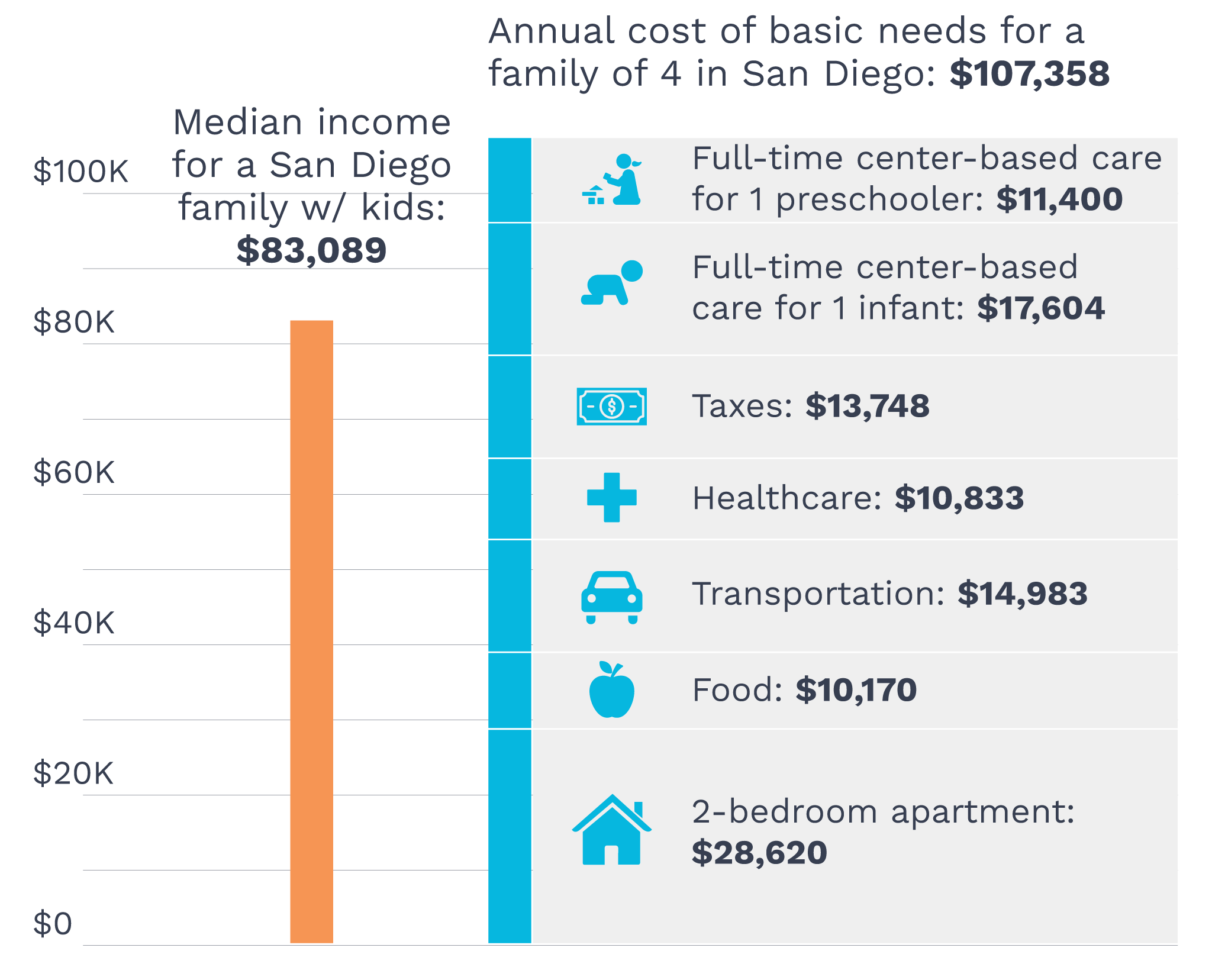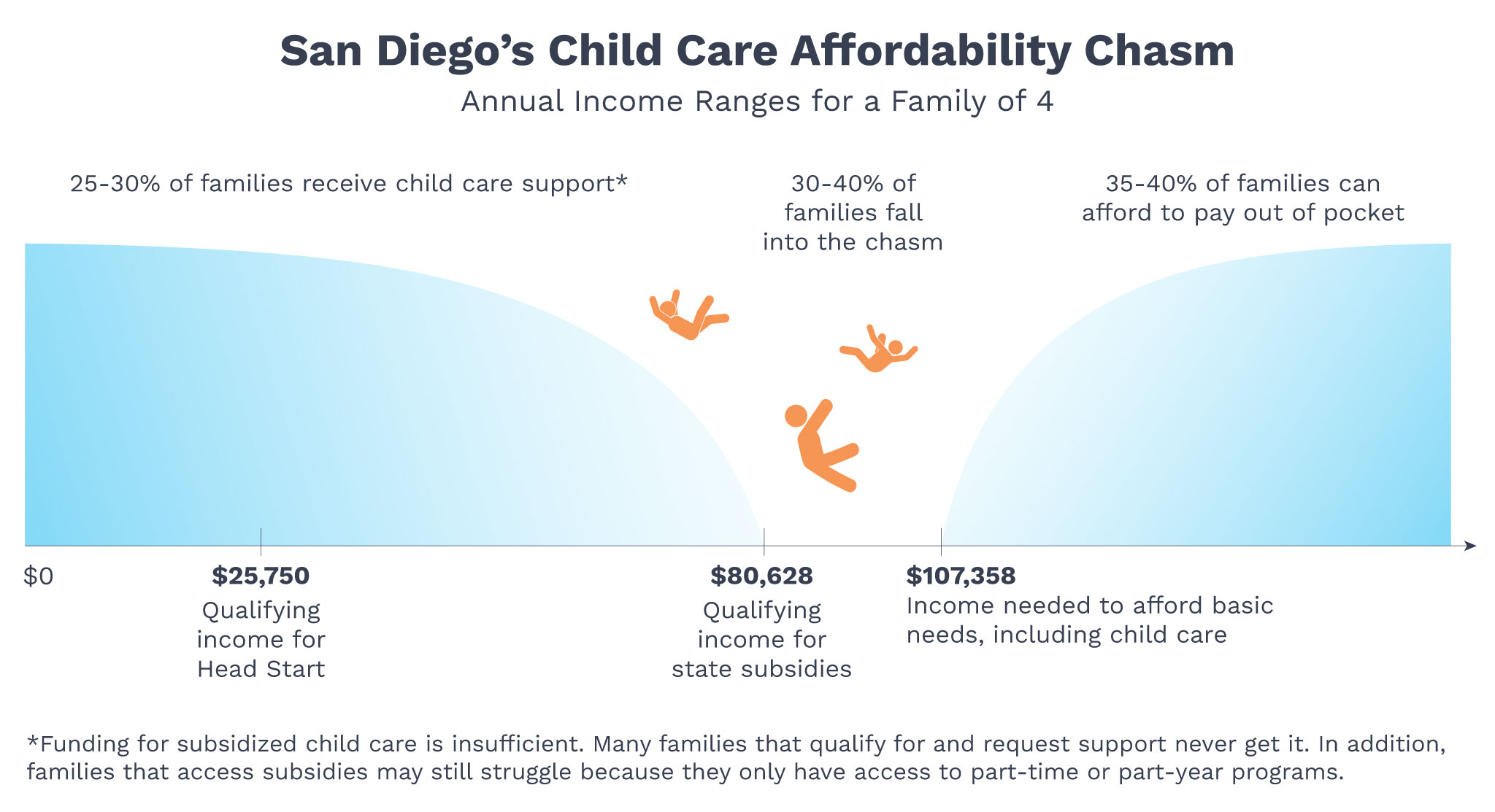Childcare options in the San Diego region are:
scarce
inconvenient
unaffordable
of varying
quality
The combination of these factors forces parents to leave, never enter, or struggle in the workforce.
This is bad for the local economy, families, and children too.
“
Finding childcare is difficult in every sense of the word.
— Suley, San Diego Parent
1. Childcare options are scarce …
Get in line
Childcare is hard for many parents to find because supply is insufficient to keep up with demand
Nearly 190,000 children in San Diego County under 12 have no stay-at-home parent and no available childcare spot.
%
of San Diego families with young kids live in childcare "deserts"
A childcare desert is defined as a geographic area where fewer than 3 childcare spots are available for every 10 children under age 6.13 These areas are highlighted in orange on the map.
Source: San Diego Regional EDC
Infant and toddler care is particularly hard to find

Less than 20% of childcare providers are licensed for infants, and the number of home-based programs for infants is decreasing12
83% of parents seeking childcare referrals for 0-5 year-olds need full-time care14
A recent study of San Diego childcare found the greatest need in our region is for full-time infant and toddler care.15
2. Childcare options are inconvenient …
Brent’s Story
Father of three children under the age of ten, Brent and his wife juggle multiple childcare schedules and locations while meeting the demands of their full-time jobs.
“
The after-school program will end with the school year and then we have no coverage for our older children. Work has definitely been impacted due to travel time for pickups and drop offs – also child carecenters closing on holidays (or school breaks) that our workplace does not observe.
— Brent, South Bay San Diego Parent
Hospitality, retail, first responder and healthcare workers with unpredictable or non-standard work schedules have very few options for licensed childcare.

“
My training is in the medical field, but I cannot do that type of work anymore because the job hours don’t match up with what I can get for childcare.
— Stephany, San Diego Parent
Lack of childcare cited as primary cause of involuntary part-time hours16
Lack of consistent work schedule and ability to schedule care in advance adversely impacts low-wage workers
Famo’s Story
Mother of two, Famo, moved to the US in 2011 as a refugee from Kenya. After having her daughter, Famo enrolled in school full time to study photography and now works part time at a community based nonprofit. Like many of her peers, she found the childcare system confusing, especially as a non-English speaker. While she was able to secure care, she worries about the long-term impact on refugees, refugee women in particular, who cannot access childcare.

“
[Finding childcare] is a long process and so many things get lost in translation. I see moms who really struggle with the process. When you are overwhelmed with the system, you leave it. Most of the moms that I know give up — they cannot understand or meet all the requirements of the process. They are trying to make a better life for their children, but they give up going to school or can’t meet the hours at work because they can’t find someone to watch their kids on a flexible schedule. They ask favors and try to get someone to cover them with their child. It is not an easy way.
— Famo, City Heights Parent
3. Childcare options are unaffordable …
With the high price of childcare and high costs of housing, food and transportation, San Diego has a childcare affordability chasm
Many families that earn too much to qualify for subsidies still cannot afford to pay out of pocket for childcare.
Head Start, a federally funded program, follows the federal poverty level for eligibility ($25,750 for a family of 4)20
State funded voucher programs such as the Alternative Payment Program base income eligibility on a % of the state median income (maximum gross income of $80,628 for a family of 4)21
A family of 4 in San Diego needs to earn more than $107,358 to afford paying for childcare out of pocket.18
Clay’s Story

“
My wife and I live within 5 miles of two high quality state-funded preschools. However, we make more than the criteria for a family of 3 … It is looking more and more like we are going to need to transport him to our closest non-subsidized district preschool which is 25 minutes away, in the opposite direction of work. Or we will need to move. It feels like a lose-lose.
— Clay, South Bay San Diego Parent
While the price of childcare is high, the sector relies on an underpaid workforce
4. Childcare options are of varying quality …
Lisa’s Story

“
I searched for quality affordable daycare [for my baby] for months. It is a difficult decision because you are trusting people you do not know with the most important and fragile thing you have in hope that they will care for them with the love and kindness that you do. You question every day if you made the right decision for your family. Being that I work with children, the cost of childcare is comparable to my salary. I know being a working mom is what is best for me, but given my struggle to find care that I truly trust and feel confident with, I wonder if it is the best thing for my daughter.
— Lisa, Poway Parent
Quality is critical for children but parents often settle for mediocre (or worse) care they can find and afford

Parents may not know what to look for, and lack knowledge of regulations for home and center-based care26
At the same time, the scarcity of options means that many parents don’t have the luxury of choosing for quality
Parents often have to compromise on quality in order to find childcare that aligns with their work hours or location
Low quality care can be detrimental to children’s development.
Stephany’s Story
Stephany, mother of a four year old daughter, was unhappy about her center-based childcare and wanted to make a change. She had concerns about her child’s safety, specifically with the front gate of the center continuously being left unlocked or open. When deciding whether to make a change, concerns about possible implications for her job weighed heavily on her mind. She knew she would have to take time off during the day to find and place her daughter in a new center.
“
I was terrified of backlash. I was thinking, what would this mean for my job? I had to take a lot of time off, having meetings with the school and different people. I have worried about them firing me because of it. If I can’t meet the hours they set for me, why wouldn’t they fire me?
— Stephany
Childcare options are scarce, inconvenient, unaffordable, and of unknown quality …
The combination of these factors forces parents to leave, never enter, or struggle in the workforce …
this is bad for the local economy, parents and children too …




